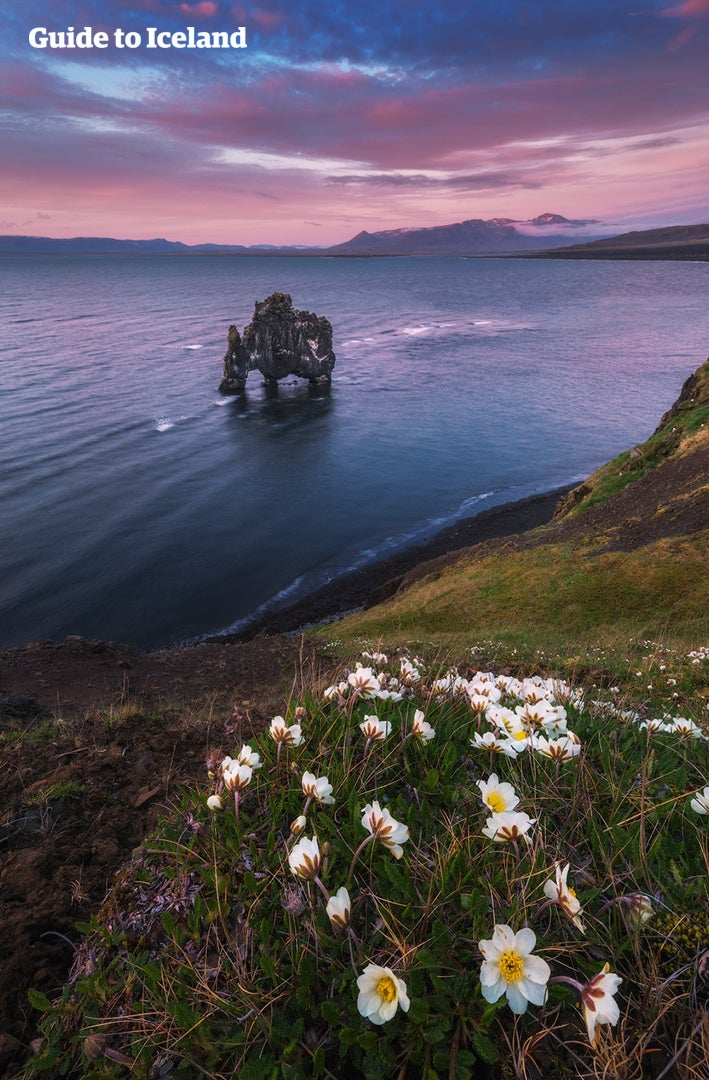ฮวิทแซร์คูร์ หรือที่รู้จักกันในชื่อ “โทรลล์แห่งภาคตะวันตกเฉียงเหนือของไอซ์แลนด์” เป็นหินบะซอลต์สูง 15 เมตร (49 ฟุต) โผล่ขึ้นจากอ่าวฮูนาฟลอย์ (Húnaflói) หินก้อนนี้เป็นแหล่งทำรังของนกนางนวล นกกาน้ำ และนกฟุลมาร์ ทำให้ดูเหมือนมีการเคลื่อนไหวอยู่ตลอดเวลา เสริมความคิดที่ว่าฮวิทแซร์คูร์เป็นสิ่งมีชีวิต
วิธีที่ดีที่สุดในการเยี่ยมชมฮวิทแซร์คูร์คือการใช้บริการทัวร์ขับรถเที่ยวเองแบบสบายๆ หนึ่งในตัวเลือกที่ดีที่สุดคือทัวร์ขับรถ 7 วันตามเส้นทางชายฝั่งอาร์กติก ซึ่งสามารถทำได้ในช่วงฤดูร้อน
ทำไมคุณถึงวางใจในเนื้อหาของเราได้
Guide to Iceland คือแพลตฟอร์มท่องเที่ยวที่น่าเชื่อถือที่สุดในไอซ์แลนด์ ในแต่ละปี เราช่วยเหลือนักท่องเที่ยวหลายล้านคน เนื้อหาทั้งหมดของเราเขียนและตรวจสอบโดยผู้เชี่ยวชาญท้องถิ่นที่รู้จักไอซ์แลนด์อย่างลึกซึ้ง คุณจึงมั่นใจได้ว่าคำแนะนำด้านการท่องเที่ยวของเรามีความถูกต้อง ทันสมัย และเชื่อถือได้
ฮวิทแซร์คูร์สามารถชมได้ดีที่สุดจากชายฝั่งตะวันออกของคาบสมุทรวาทน์สเนส (Vatnsnes Peninsula) ชื่อของมันมาจากนกหลายชนิดที่ทำรังบนยอดหิน ในภาษาไอซ์แลนด์ ฮวิทแซร์คูร์หมายถึง “เสื้อเชิ้ตสีขาว” ซึ่งเป็นการสื่อถึงสีของมูลนกที่ปกคลุมหินก้อนนี้
ช่างภาพมักถูกดึงดูดให้มาถ่ายรูปฮวิทแซร์คูร์ เนื่องจากเมื่อแสงจากดวงอาทิตย์ ดวงจันทร์ และแสงเหนือสะท้อนบนผืนน้ำราบรอบหินรูปทรงโดดเด่นนี้ ทำให้ได้ภาพที่สวยงามและมีเอกลักษณ์
เรื่องเล่าของฮวิทแซร์คูร์
ไม่ใช่เรื่องแปลกที่ฮวิทแซร์คูร์มักถูกเรียกว่า “โทรลล์” เพราะหินรูปร่างโดดเด่นหลายก้อนในไอซ์แลนด์ก็มีเรื่องเล่าแบบนี้เช่นกัน ตามตำนานเล่าว่าฮวิทแซร์คูร์เดิมเป็นโทรลล์จากคาบสมุทรแห่งนี้ ซึ่งตั้งใจจะปีนไปฉีกระฆังของคอนแวนต์ธิงเกย์ราคลอสตูร์ (Þingeyraklaustur) โดยโทรลล์นั้นแตกต่างจากเอลฟ์ตรงที่พวกมันกลัวศาสนาคริสต์
สัตว์ประหลาดตัวนี้โกรธและดื้อรั้นมาก จนไม่ทันสังเกตว่าดวงอาทิตย์ขึ้น และถูกแสงแดดสาดส่องจนแข็งเป็นหินไปตลอดกาล
มองย้อนกลับไป เรื่องเล่านี้คล้ายกับนิทานพื้นบ้านไอซ์แลนด์อื่นๆ ที่แฝงสาระเกี่ยวกับศาสนาคริสต์อย่างลึกซึ้ง เรื่องนี้น่าจะสื่อถึงความอดทนของชาวไอซ์แลนด์ต่อการแปลงศาสนาคริสต์ โดยเปรียบเทียบว่าผู้ที่ยึดมั่นในความเชื่อเดิมนั้นดื้อรั้น โง่ร้าย และชั่วร้ายเหมือนโทรลล์ และอาจเผชิญชะตากรรมคล้ายกัน
ไอซ์แลนด์เปลี่ยนมานับถือศาสนาคริสต์ในปี 1000 ภายใต้แรงกดดันจากการคุกคามของนอร์เวย์ และการเปลี่ยนแปลงนี้ไม่ง่าย ผู้ที่ยังนับถือเทพเจ้าโบราณของนอร์สถูกกีดกันและลงโทษไปอีกนานหลายร้อยปี
การก่อตัวของฮวิทแซร์คูร์

นักวิทยาศาสตร์มีคำอธิบายอีกแบบเกี่ยวกับการเกิดของฮวิทแซร์คูร์ การกัดเซาะจากคลื่นทะเลที่ซัดเข้ามาได้สร้างโพรงใหญ่สามช่องผ่านหินบะซอลต์ ทำให้หินมีรูปร่างเหมือนสัตว์ในตำนานที่แข็งเป็นหิน
ฐานของก้อนหินถูกเสริมความแข็งแรงด้วยคอนกรีตเพื่อป้องกันไม่ให้ทะเลกัดเซาะ แต่สิ่งนี้ก็ไม่สามารถหยุดนักท่องเที่ยวจากการตีความรูปร่างแปลกของหินได้
บางคนบอกว่าฮวิทแซร์คูร์ดูเหมือนช้างมากกว่าตัวโทรลล์ ขณะที่บางคนเห็นว่ามันคล้ายแรด และยังมีผู้ชมบางคนอ้างว่าหินนี้ดูเหมือนมังกรหรือไดโนเสาร์กำลังดื่มน้ำ
สถานที่ใกล้ฮวิทแซร์คูร์
ฮวิทแซร์คูร์ตั้งอยู่บนคาบสมุทรวาทน์สเนส ซึ่งเป็นจุดชมแมวน้ำที่ดีที่สุดในประเทศ ในเมืองฮวามม์สตางกิ (Hvammstangi) มีศูนย์แมวน้ำไอซ์แลนด์ (Icelandic Seal Centre) ให้ผู้มาเยือนได้เรียนรู้ว่าพฤติกรรมและชีวิตของสัตว์น่ารักเหล่านี้มีอิทธิพลต่อการดำรงอยู่และตำนานพื้นบ้านของประเทศอย่างไร เมืองนี้ยังมีร้านค้าเล็กๆ และร้านอาหารพร้อมวิวทะเลสวยงาม
ทางตอนใต้ของฮวิทแซร์คูร์คือชายหาดซิกรีดาร์สตาดีร์ (Sigríðarstaðir) ซึ่งถือเป็นจุดชมแมวน้ำที่เชื่อถือได้และคุ้มค่าที่สุดในประเทศ
ฮวิทแซร์คูร์ยังอยู่ไม่ไกลจากฟาร์มซูลูเวลลิร์ (Súluvellir) ฟาร์มประวัติศาสตร์ที่มีทิวทัศน์รอบด้านสวยงามและเป็นเอกลักษณ์อีกด้วย










